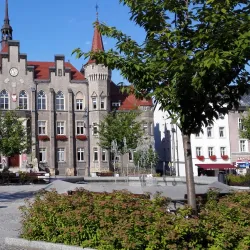Traffic Summary for Walbrzych
In 2024, Walbrzych's transportation landscape is dominated by car usage, with 100% of commuters relying on this mode of transport. The city's traffic data reveals significant CO2 emissions and highlights areas for potential improvement in public transportation options.
Average Commute Times
- Car - Car commuters in Walbrzych experience a 15-minute drive covering 4 kilometers, with no significant waiting times reported.
Traffic Breakdown
Seasonal Trends
Traffic tends to increase during winter months due to adverse weather conditions affecting driving. Summer sees a slight decrease in traffic as residents take vacations.
Commuter Pain Points
Limited public transportation options force reliance on cars, increasing traffic congestion. High CO2 emissions are a concern for environmentally conscious residents.
Best Travel Times
Early mornings before 8 AM and late evenings after 7 PM are the best times to avoid traffic congestion. Midday travel is generally smoother due to lower traffic volumes.
Event Impacts
Public events in the city center can significantly disrupt traffic flow, especially during weekends. Concerts and festivals often lead to temporary road closures and increased congestion.
Sustainability Efforts
The city is exploring initiatives to promote cycling and walking as viable commuting options. Efforts are underway to improve the efficiency and reach of public transportation systems.
Ride-Sharing Impact
Ride-sharing services are slowly gaining popularity, offering an alternative to car ownership. These services help reduce the number of vehicles on the road, potentially easing congestion.
Traffic Rankings
The Traffic Index for Poland combines user-contributed data on commute times, traffic dissatisfaction, CO2 emissions, and traffic system inefficiencies in Poland, to provide insights into overall traffic conditions.
Traffic Data
Overall average travel
Average when primarily using Car
"Key Takeaways"
Walbrzych's heavy reliance on cars presents opportunities to expand public transportation options.
Reducing CO2 emissions should be a priority, potentially through increased use of sustainable transport methods.
Key Indexes
EmissionsWalbrzych has a high CO2 emission index of 3990, indicating significant environmental impact from transportation.
The reliance on cars contributes heavily to the city's carbon footprint.
TimeThe time index of 15 suggests relatively short commute durations, primarily due to the small city size.
Despite short distances, traffic inefficiencies are present.
InefficiencyAn inefficiency index of 39.67 highlights potential delays and suboptimal traffic flow.
Improving public transport could alleviate some inefficiencies.
















